How to grow strawberries in pots – our easy guide to help you grow your own
Learn how to grow strawberries in pots and cultivate a delicious crop on your patio or balcony
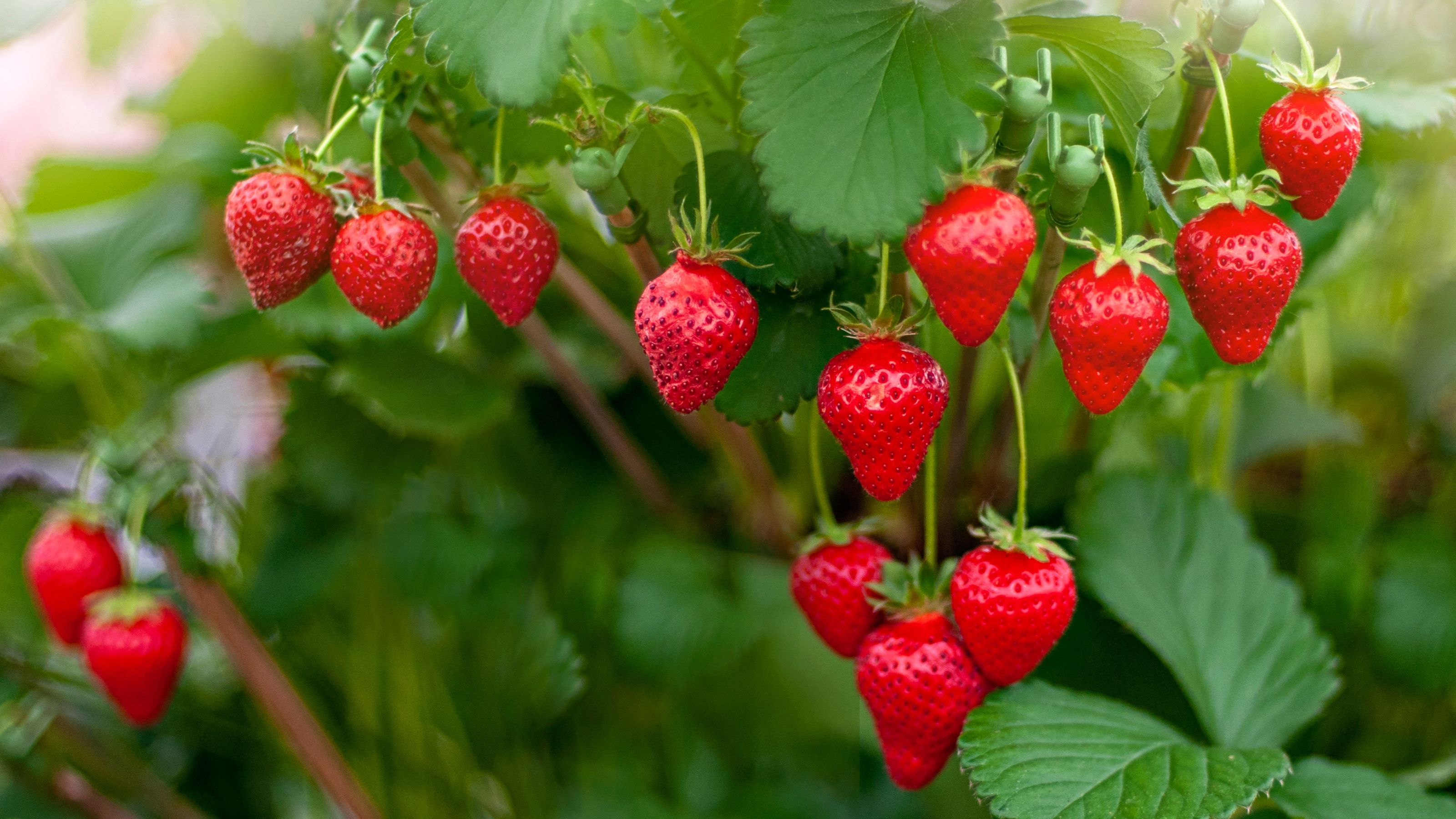

From strawberries and cream to Eton mess, learning how to grow strawberries in pots is a cost-effective and rewarding way to enjoy one of our country's favourite fruits.
What's more, learning how to grow strawberries in pots is really straightforward – especially when grown in pots – and will make for a fruitful addition to your garden ideas.
'Strawberries are very versatile and can be planted in hanging baskets, grow bags, pots or even deep galvanised gutters. Make sure you use a good multipurpose compost with some loam mixed in,' says Sarah Raven, plantswoman and author of A Year Full of Veg.

Since the publication of her first book, The Cutting Garden, Sarah led the way in introducing a new kind of productive gardening. Sarah’s expertise extends to all areas, from cut flowers and vegetables to designing gardens packed with colour, and scent. Her gardening podcast has achieved 2.6 million downloads; she’s published 12 books and runs SarahRaven.com which services over 600,000 customers.
How to grow strawberries in pots
Growing your own is a very popular garden trend and strawberries are a great place to start. There are several approaches when it comes to learning how to grow strawberries in pots – some easier than others.
The most popular and easiest method is to use bare-root plants – such as those below. Not only are they very durable but they are also cheaper to purchase – you are not having to pay for pots or compost – especially if you are ordering online. Bare-root is also the most environmentally-friendly choice, as they are both peat- and plastic-free.

Ready-purchased plants are another popular alternative – these will be more expensive but will grow more quickly than bare-root (as they arrive in a state of active growth rather than dormancy). Strawberry plugs also have a greater success rate than bare root – 'the average loss rate of plugs is only 1 to 2 per cent compared to 15 to 20 per cent for bare-root plants,' explains experts at Ison's Nursery.

You can also clone existing strawberry plants from runners – this is a free and easy method of multiplying a single plant.
Strawberries are not traditionally grown from seeds. 'Using the seeds means a longer process, they need to go through a cold phase for several weeks before planting,' says Julian Palphramand, head of plants at British Garden Centres. Purchasing bare root or plug strawberry plants is a much more efficient method where you are also much more likely to see success.
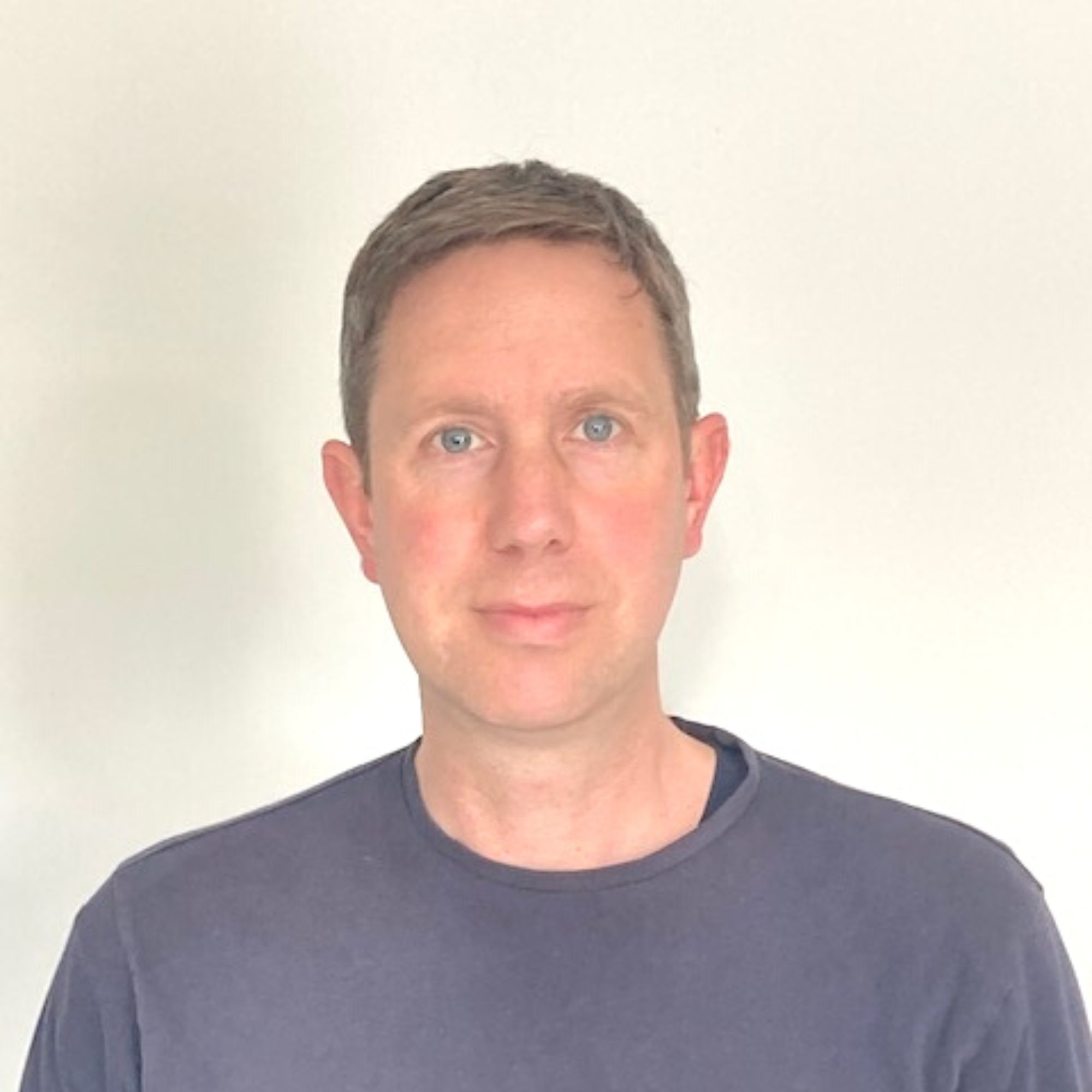
Julian Palphramand is Head of Plants at British Garden Centres. He was previously Horticulture Buyer at Wyevale Garden Centres and had extensive knowledge of various plants and advice on the best approaches to growing them.
What you'll need
- Strawberry plants: bare-root or plug plant
- A pot with 6 inches in diameter per strawberry plant – for multiple plants per pot ensure at least 6 inches per plant
- Trowel
- Peat-free multi-purpose compost
- Fertiliser
How to grow strawberries step-by-step
Considering that we keep spotting the strawberry motif trend everywhere as a growing home decor trend, it seems a shame not to add this beautiful fruit into our gardens too.
'The ideal time to start growing your strawberries is in April and May for plants that will produce fruits in June and July,' explains Daniel Carruthers, grow your own expert at Cultivar Greenhouses.
1. Choose your pot

Regardless of whether you grow strawberries from plugs (as seen in the picture) or bare-root, the first step is to pick your pot. Perfect for small gardens, you can grow strawberries in any style of pot but some are better than others.
'Many think a specialist strawberry urn is the best way to grow strawberries, as they have several openings along the sides of the pots for strawberries to flourish. While these are tried and tested containers to grow your plants, you can also use any standard pot, planter or even use them to plant a hanging basket, as long as it has free drainage to prevent the compost from becoming waterlogged,' explains Daniel Carruthers, grow your own expert at Cultivar Greenhouses. There are plenty of strawberry planters to shop on Amazon, like this strawberry planter stacking pot.
Terracotta pots are often preferred as they offer better drainage than plastic pots. If you are growing one strawberry per pot then your pot should have a minimum of six inches diameter. For each extra plant you introduce to the pot add another six inches in diameter – for example, if growing three strawberry plants in the same pot look for one that's at least 15 inches in diameter.
2. Prepare your strawberry plants

Once you've chosen your pot you need to fill it with compost – 'make sure you use a good peat-free multipurpose compost with some loam mixed in,' recommends plantswoman Sarah Raven– Miracle-Gro's Premium All-Purpose Compost is a good choice.
Once you've filled your pot, the next step is to prepare your plants. For plug plants, this means gently removing them from their growing cell by gently squeezing each side of the cell and tipping out the plant – be careful not to squish the foliage.
For bare-root strawberry plants, submerge the plants in a bucket of water for 20 minutes before planting.
3. Pot up your strawberry plant

If you want to grow strawberries in pots, then start by digging a hole that is as deep as the roots.
'Whether growing plug plants or bare-root, the strawberry plant's roots need to be completely covered with soil, and usually, they are quite long, so in other words, the hole does need to be quite deep. But do not bury the crown, as that can cause rot to set in,' explains plantswoman Sarah Raven.
4. Firm in place
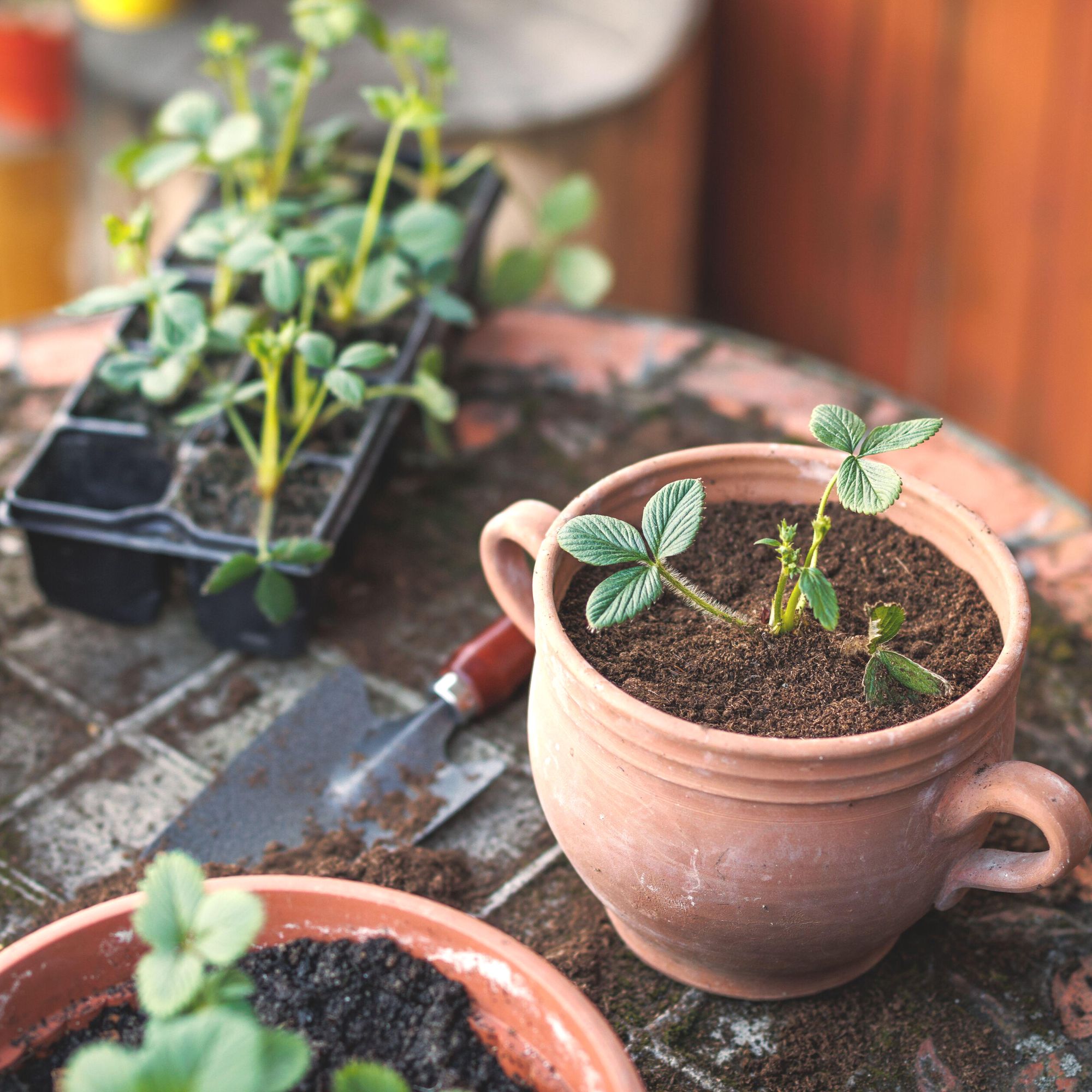
Ensure your strawberry plant is firmly in its new pot and will not topple when left unsupported – you may need to add a little extra compost depending on the size of the hole your dug and the size of your plant.
5. Place in a sunny yet sheltered spot
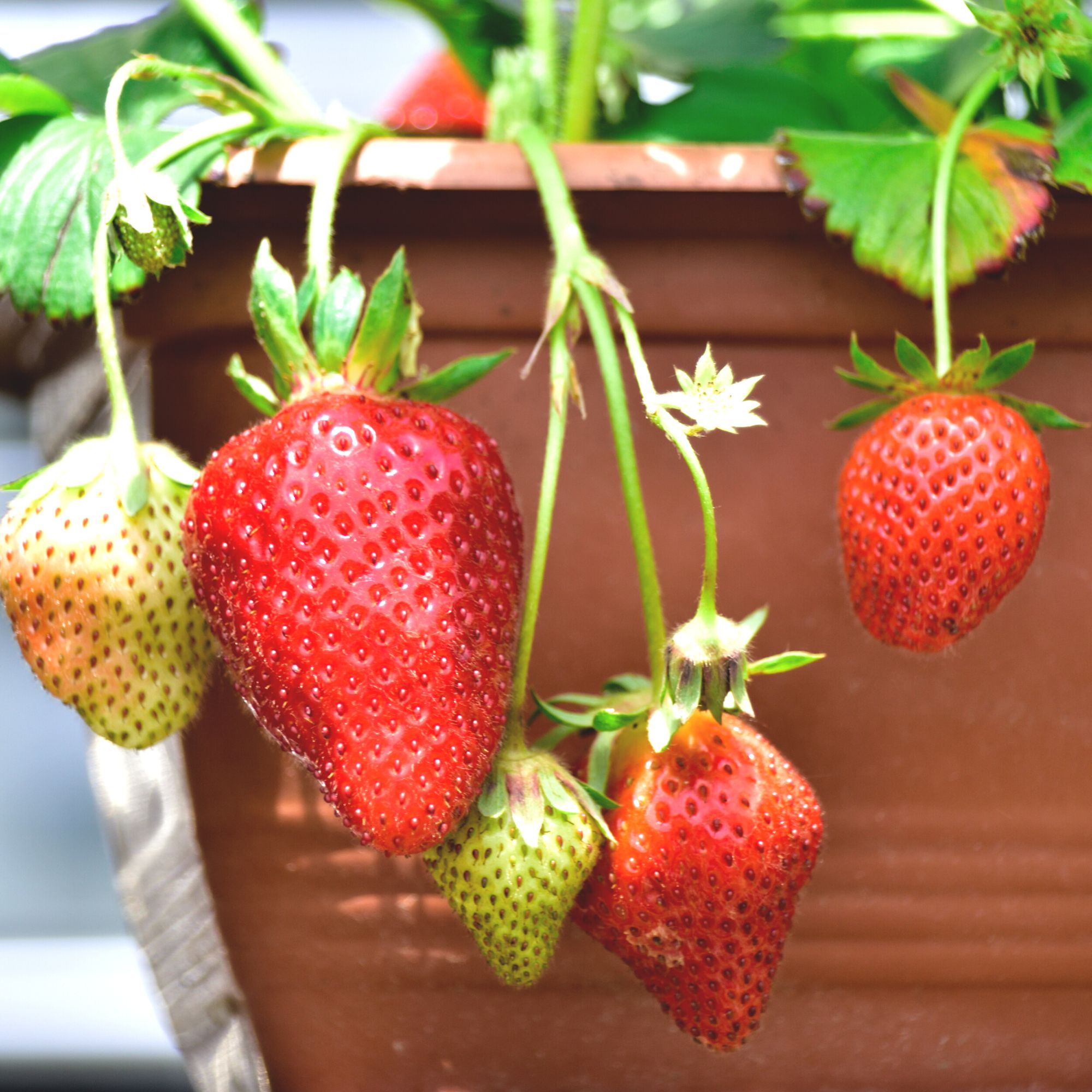
Strawberry plants thrive on sunlight. 'Place plants in a sunny spot that receives around ten to twelve hours of sunlight a day, but ensure that they are sheltered from high winds,' advises Daniel Carruthers, grow your own expert at Cultivar Greenhouses. 'Simply ensure they are kept well-watered, and come summertime you will be able to enjoy plump, juicy, and sweet strawberries!'
It is also important to protect your plants from birds or other predators – otherwise, you'll get no opportunity to enjoy the fruits of your labours. 'Cover with net once fruit starts to ripen,' says Sarah Raven. 'You could even grow strawberries in pots in an unheated greenhouse to encourage an even earlier crop.'
If you don't already have a greenhouse in your garden there are lots of DIY greenhouse ideas that are an affordable way to foster your potted strawberry plants.
6. Water thoroughly

When growing strawberries in pots, watering is vital. 'The downside is that most pots are porous, so anything planted in terracotta tends to dry out much faster,' says Julian Palphramand, head of plants at British Garden Centres. 'One way to combat this challenge is to water whenever the soil is dry half an inch below the surface. Do not overwater as constant damp soil encourages disease and rot.'
7. Fertilise regularly with tomato feed

When growing plants in pots, fertiliser is key. Within a few weeks, the nutrients in your soil will have significantly depleted and the roots cannot spread out in order to find more. Therefore, it is vital that you fertilise your strawberry plants in pots. 'Feed with a liquid feed high in potash and low in nitrates,' advises Julian Palphramand, head of plants at British Garden Centres.
'Often, a tomato food – such as Levington's Tomorite on Amazon – will do the job perfectly!' seconds Daniel Carruthers, grow your own expert at Cultivar Greenhouses.
8. Harvest your delicious crop
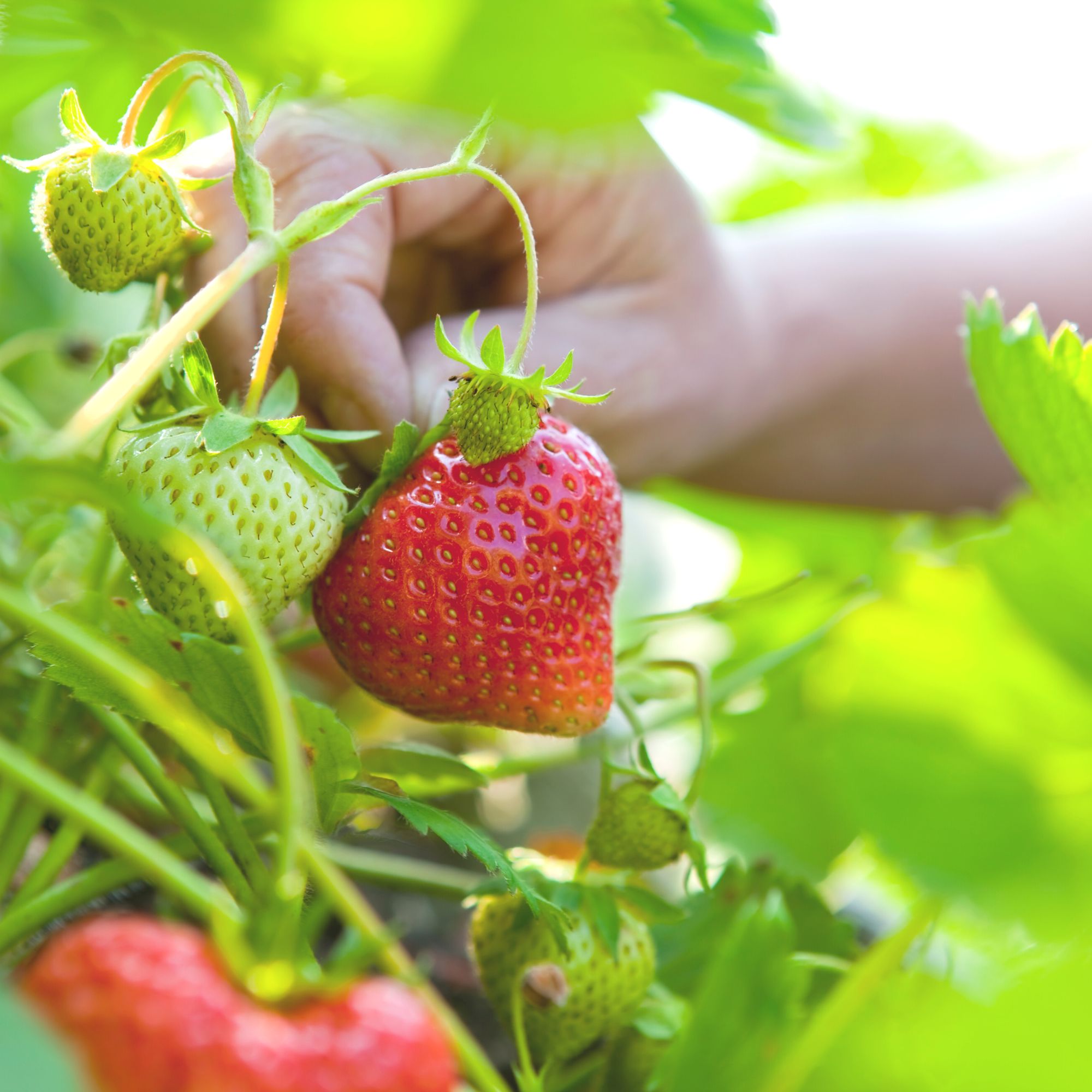
Within a few months of planting your strawberries, you'll have your first crop of fruit. 'Early varieties will be ready to harvest in May, midseason varieties in June and late varieties in July,' says Sarah Raven.
Perpetual strawberries – such as Strawberry 'Montana' available at Sarah Raven – produce small flushes of fruits from early summer to early autumn. With this long, light cropping we often find the birds don’t realise and so don’t nick all the fruit and you can get away without netting.'
'Pick when fully ripe complete with stalks and use at once for the best flavour. These will keep in the fridge for a couple of days or are delicious when turned into jam or compote with rhubarb..'
9. Propagate to get more plants for free
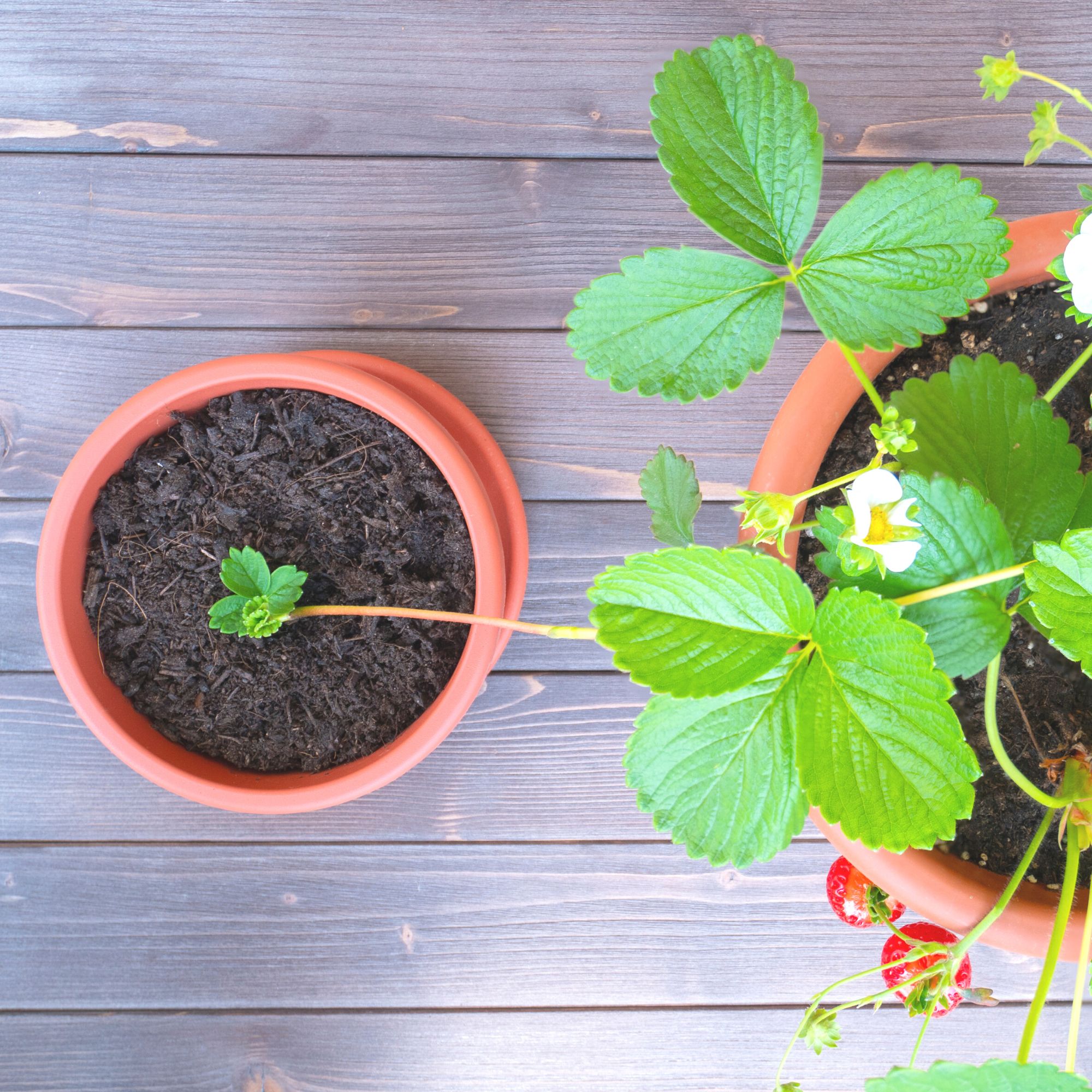
Once your strawberry plants are thriving your can then propagate them to produce more plants for free. 'Most strawberries produce long shoots which, if left to their own devices, will root wherever they fancy, and you’ll end up with a dense mass of plants rather than the neat rows you started with,' explains Sarah Raven.
'They can be persuaded to root into a pot of compost by pegging them down with a piece of bent wire. Then when the plant is safely rooted in the pot you can cut it off from the mother plant and plant it exactly where you want it.'
'After three years or so your patch or pots will begin to tire, so it is worth propagating at this stage and moving to a newly fertilised and prepared position,' she adds.
Gardening FAQs
Why might your strawberry plant not be fruiting?
There are lots of possible reasons why your strawberry plant might not be fruiting – Julian Palphramand, head of plants at British Garden Centres explains the most popular reasons.
- Soil has insufficient nutrients – not enough nutrients to grow fruit.
- Underwatering – your strawberry plants will put all their energy into surviving and not producing fruit.
- Too much heat – although strawberries like at least six hours of sun a day, if overexposed to heat in a container will cause hot roots.
- Too much shade – will not be able to photosynthesize and will struggle to produce fruit.
- Lack of insects – this will impact pollination. Try growing a few companion plants such as borage, thyme, rosemary, nasturtiums or poppies to attract bees and butterflies to your container.
Can you grow strawberry plants from shop-bought strawberries? (i.e. taking the seeds off the fruit)
Yes, you can grow strawberry plants from shop-bought strawberries but it isn't easy. 'Begin by thinly slicing the outer layer of a strawberry. Take these pieces of skin and place them in a grow pot filled about two-thirds of the way with compost, then cover them with a thin layer of compost. Lightly mist the top of the soil with water, cover it with cling film to help retain moisture and warmth, and place it on a sunny windowsill or in your greenhouse. In a couple of weeks, you should see your strawberry plant begin to germinate,' says Daniel Carruthers, grow your own expert at Cultivar Greenhouses.
However, if you are trying this method it is best to purchase organic strawberries. 'Lots of shop-bought strawberries will have been sprayed with pesticides which will give poorer results and can prevent germination,' advises Julian Palphramand, head of plants at British Garden Centres.
What is the best pot for growing strawberries?
The best pot for growing strawberries is a 6-inch diameter terracotta pot.
'Many think a specialist strawberry urn is the best way to grow strawberries, as they have several openings along the sides of the pots for strawberries to flourish. However, they are not the only option to grow strawberries in pots, you can also use any standard pot, planter or hanging basket, as long as it has free drainage to prevent the compost from becoming waterlogged,' says Daniel Carruthers, grow your own expert at Cultivar Greenhouses.
What diseases do strawberry plants get?
There are lots of diseases that can affect strawberries. Sarah Raven talks us through the most common strawberry plant diseases and how to treat them.
- Strawberry grey mould: a common fungal disease that attacks the ripening fruit, particularly during rainy weather. Remove infected fruits promptly and maintain good airflow around the plants.
- Strawberry black eye: The centre of the flower turns dark brown or black, while the rest of the plant appears quite healthy. This is caused by frost damage to the young flower – protect from frost with cloches or horticultural fleece.
- Strawberry virus: This will stunt the whole plant and create mosaic-like streaking on the leaves which will eventually turn yellow and drop off. The affected plants should be destroyed and watch out for future infestations of aphids which often spread the virus. Only buy plants from certified virus-free stock.
- Vine weevil: vine weevil that attacks a lot of plants including strawberries, and particularly those grown in pots. If the plant looks sickly it is worth turning out the pot and looking for the tell-tale white grubs that will be feeding off the roots. They hatch into small black beetles which then feed on the edges of leaves, making small, neat notches. Clean off and treat with nematodes.
Get the Ideal Home Newsletter
Sign up to our newsletter for style and decor inspiration, house makeovers, project advice and more.

Holly is one of Ideal Home’s content editors. Starting her career in 2018 as a feature writer and sub-editor for Period Living magazine, she has continued this role also adding regular features for Country Homes & Interiors and the Ideal Home website to her roster. Holly has a passion for traditional and country-inspired interiors – especially kitchen design – and is happiest when exploring the countryside and hills of the Lake District. A keen gardener, she is a strong believer that you can never have too many houseplants.
-
 Will a conservatory add value to your home and how can you maximise it?
Will a conservatory add value to your home and how can you maximise it?This is what the pros say
By Amy Reeves
-
 I’ve been looking for a new signature scent for my home and The White Company's new fragrance is the exact summer holiday smell I needed
I’ve been looking for a new signature scent for my home and The White Company's new fragrance is the exact summer holiday smell I neededSantorini smells fresh, summery and sophisticated
By Kezia Reynolds
-
 How to remove algae from garden walls in five steps – and the cleaning product experts rave about for tackling it fast
How to remove algae from garden walls in five steps – and the cleaning product experts rave about for tackling it fastExperts share their top tips for getting garden walls algae-free
By Katie Sims